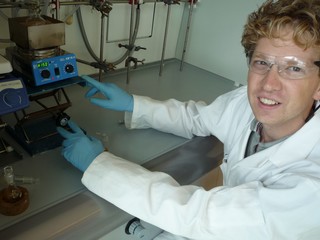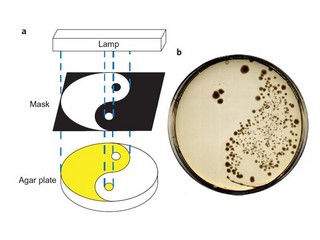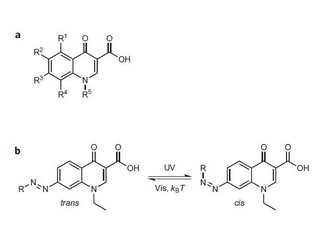An antibiotic with an ‘on’ switch

Medicine that you switch on could be the next thing in targeted therapy. It would also prevent antibiotics from accumulating in the environment. Chemists from the University of Groningen have developed an antibiotic with an ‘on’ switch, and have published their findings in Nature Chemistry .
Most of the medication we use ends up in the sewage system and ultimately in the environment. Many streams have been found to have measurable concentrations of oestrogens (from birth-control pills), anti-depressants or antibiotics, the last of which can induce resistance in bacteria.
An innovative solution to this problem would be to control the activity of antibiotics with a switch. This idea surfaced in the research group of Professor of Organic Chemistry Ben Feringa, who is a pioneer in the field of optical molecular switches. He set his PhD student Willem Velema the task of creating such an antibiotic, whilst he and the molecular biology group of Arnold Driessen examined its effect on bacteria.
Velema explains that this is part science, part art. By attaching the switch, he was changing the antibiotic’s shape. ‘We knew the structure of the complex that the antibiotic attaches itself to, so we had some idea of where we could fiddle with it.’ But in the end, there’s an element of trial and error. ‘I made nine different compounds, and one of them turned out very well.’

The antibiotic-with-a-switch is inactive to start with, but if you irradiate it with ultraviolet light, part of the switch flips, and this activates the antibiotic. In chemical terms: the switch goes from a trans-isomer to a cis-isomer. However, the activated antibiotic is not stable: with a half life of around two hours, it reverts to a trans-isomer. This means that if the antibiotic is activated just before use, most of it will be inactive by the time it reaches the sewers.
However, it will be years before any real medicine with such a switch comes on the market, says Ben Feringa. ‘Designing and testing a drug for use in humans easily takes up to ten years.’ Although the antibiotic they used is tried and tested, the added switch could change its properties. ‘Our main aim was simply to prove that we can use the light-drive switch to control the biological activity of a molecule.’
The new switchable antibiotic can also be used for all kinds of research. The ability to turn it on at will opens up all sorts of possibilities. The scientists gave one such example in their Nature Chemistry paper. They grew bacteria on a plate containing the antibiotic. They then used a mask with the Yin-Yang symbol cut into it and irradiated the plate, thus activating the antibiotic in specific places and causing the bacteria to grow in a Yin-Yang pattern.

In the long run, there are interesting medical applications as well. ‘For example, a patient with a skin infection could be given the inactive form. You could then use ultraviolet light to activate the antibiotic in the exact spot where you need it.’ This targeted treatment would prevent any damage to useful intestinal bacteria. If the switch could be tuned to near-infrared light – which can penetrate deep into human tissue – this kind of therapy would have even more applications.
The Feringa group will continue to investigate the use of switch mechanisms. Velema has some fine-tuning to do. ‘I’m working on switches that respond to a different colour, which are attached to different antibiotics. And we might be able to use one of our switchable antibiotics in an animal model.’ Feringa adds that the ability to use a light signal to control how small molecules function, for medical applications or otherwise, could have major implications. ‘It is a whole new way of thinking.’
Optical control of antibacterial activity.
Willem A. Velema1, Jan Pieter van der Berg2, Mickel J. Hansen1, Wiktor Szymanski1,
Arnold J. M. Driessen2,3 and Ben L. Feringa1,3*
Nature Chemistry, online 15 September (DOI: 10.1038/nchem.1750)
1 Centre for Systems Chemistry, Stratingh Institute for Chemistry, University of Groningen, Nijenborgh 4, 9747 AG, Groningen, The Netherlands, 2 Molecular Microbiology, Groningen Biomolecular Sciences and Biotechnology Institute, Nijenborgh 7, 9747 AG, Groningen, The Netherlands, 3 Zernike Institute for Advanced Materials, University of Groningen, Nijenborgh 4, 9747 AG, Groningen, The Netherlands
| Last modified: | 20 June 2016 09.53 a.m. |
More news
-
16 April 2024
UG signs Barcelona Declaration on Open Research Information
In a significant stride toward advancing responsible research assessment and open science, the University of Groningen has officially signed the Barcelona Declaration on Open Research Information.
-
02 April 2024
Flying on wood dust
Every two weeks, UG Makers puts the spotlight on a researcher who has created something tangible, ranging from homemade measuring equipment for academic research to small or larger products that can change our daily lives. That is how UG...
-
18 March 2024
VentureLab North helps researchers to develop succesful startups
It has happened to many researchers. While working, you suddenly ask yourself: would this not be incredibly useful for people outside of my own research discipline? There are many ways to share the results of your research. For example, think of a...

